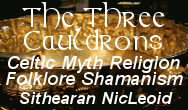Pagan Paths
The morning sun rising in the east calls to the Bright Youth in me, and the Bright Youth responds. The full moon calls to the Muse, and the waning and dark moon to the Dark Maiden who is a part of me. The earth I touch with my fingers calls to the Mother, in both her guises, Nurturing and Devouring. The bright green shoots rising from the earth and the green leaves on the trees on my street in the spring, these call to the Stag King, while the red leaves fallen to the earth in the autumn call to the Dying God. The spring storm that rises up suddenly in the west calls to the Storm King. The night sky, the dark space between the stars, calls to Mother Night, my death come to make peace. The gods-without call and the gods-within respond.
You Don't Know Jung, Part 3: Individuation
You don't know Jung ... and it's his own fault. Jung concepts are frequently misunderstood by Pagans, both by those who love him and those who hate him. Part of the confusion surrounding Jung is due to his choice of terminology. Jung chose terms that -- at least when translated into English -- are commonly used to mean something very different than what he intended. In this series, I discuss five Jungian terms which are easily and commonly misunderstood: psychic, energy, self, individuation, symbol, and archetype. In this part, I will talk about "individuation".
Individuation is the process by which a person integrates the conscious and unconscious parts of themselves, and thereby shifts the center of the psyche from the ego to the True Self (see the previous post on "Self"). The problem with this term is it too closely resembles, and there for is confused with, "individualism". As a consequence, the word "individuation" gives the impression of a separating and distinguishing process, while the ultimate goal of individuation is really integration and unification.
“Again and again I note that the individuation process is confused with the coming of the ego into consciousness and that the ego is in consequence identified with the self, which naturally produces a hopeless conceptual muddle. Individuation is then nothing but ego-centredness and autoeroticism. But the self comprises infinitely more than a mere ego, as the symbolism has shown from of old. It is as much one’s self, and all other selves, as the ego. Individuation does not shut one out from the world, but gathers the world to itself.” (“On the Nature of the Psyche”, CW 9, P 432).
The nature of the project of individuation is further confused by the fact that it consists of two psychic movements or phases which initially seem to be at odds with each other. The first phase is the differentiation or separation of the ego from its source in the unconscious, a kind of dis-integration. It is a necessary step in the process of individuation. Though the separation of the ego, the psyche which was previously unconscious, comes to be aware of itself. One must develop an ego, before one can sacrifice it in the second phase of individuation. In its social manifestation, this first phase often manifests as nonconformism and separation from communal identities and norms. In his essay, "Adaptation, Individuation, Collectivity", Jung a writes that individuation "means stepping over into solitude, into the cloister of the inner self." (CW 18, P 1097). Consequently, it does does appear individualistic. Much of Pagan and New Age practice is geared toward this first phase of individuation, the development of a separate ego.
However, this is only half of the process of individuation. While individuation is necessarily introspective, the process is not complete until the individual reintegrates with society, bringing with him or herself the possibility of collective renewal. Thus the process of individuation, seen as a whole, is not anti-social.
“As the individual is not just a single, separate being, but by his very existence presupposes a collective relationship, it follows that the process of individuation must lead to more intense and broader collective relationships and not to isolation.” (CW 6, P 758).
The second phase of individuation consists of a return to the unconscious source, a reintegration with the unconscious. This is often experienced as a loss of one's "self" or a kind of death of the ego. In the personal context, this takes the form of mysticism, including the more mystical forms of Paganism. In a social context, it often manifests as return to community and a re-immersion in the social group.
It has been observed that the first phase generally occurs during the first half of a person's life (into their mid-30s) and the second phase occurs in the second half. (See James Hollis, Finding Meaning in the Second Half of Life, and Richard Rohr, Falling Upward, A Spirituality for the Two Halves of Life) But, on another level, this two-phase process is an ongoing cycle that continues through a person's life. The term "individuation" does not really capture the complexity of this dynamic.
Comments
-
Please login first in order for you to submit comments



















